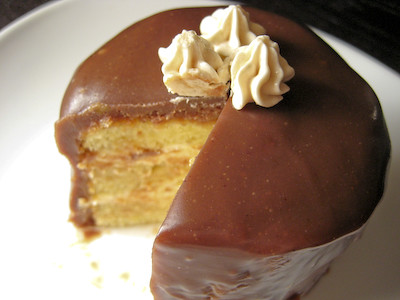
This month's Daring Bakers Challenge was chosen by Chris of Mele Cotte: the Filbert Gateau with Praline Buttercream. Filberts are more commonly known as hazelnuts and a gateau is basically a fancy word for a light sponge cake filled with a rich filling. In this case, that rich filling is a decadent praline buttercream. At first glance, this recipe looks quite similar to the May Daring Bakers Challenge (Opéra Cake). It's a layer cake, soaked in a sugar syrup, filled with buttercream, and topped with a ganache. On the surface, they're very similar - but once you start to make the gateau, you realize that this recipe teaches/hones a few other techniques and skills as well.
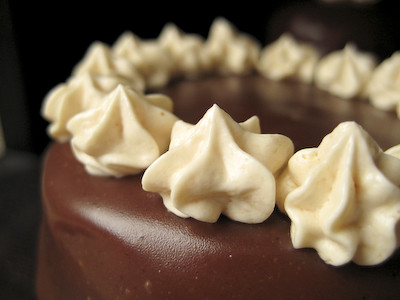
Instead of one large, round cake, I decided to make mini cakes to take to work with me (yes, my coworkers love me!). I had the perfect pan that allowed me to make eight of the most adorable little cakes! I was in such a rush to bake the cakes, that I forgot to butter and flour the pan - thankfully, since the pan has removeable bottoms, I was still able to easily remove them from the pan.
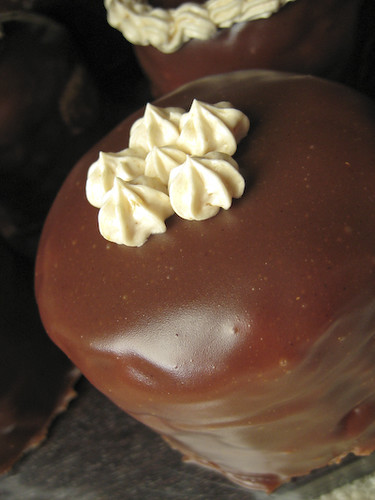
I hate nuts. But I love peanuts and hazelnuts. The most frustrating part of this recipe was dealing with the hazelnuts. I thought about purchasing them online and getting the ones that have already been peeled and roasted, but with the added costs of shipping, I decided I could just as easily buy them locally, roast and peel them myself, and save a little money. Boy did I regret that decision later!

The hazelnuts aren't quite as good if you blanch them before peeling them (it partially cooks them), so I tried just roasting them and then peeling them. The skins don't rub off quite as easily as you would hope - I was only able to peel about half of my hazelnuts using this method. The other half I had to blanch in boiling water, and then roast. It was extremely labor intensive. But when all of the hazelnuts were peeled and I had my pile of hazelnuts skins, I had a huge sense of accomplishment. Look - they look like raked up leaves on an autumn day! :)

This was my first time making and tasting praline paste - I had actually never heard of it before. You basically make a candy brittle with the hazelnuts by caramelizing sugar and mixing the nuts in, then break the brittle into pieces and process in the food processor until it becomes a thick paste. Pure liquid heaven. I could eat the stuff by the spoonful! This was definitely my favorite component of the challenge. A few other bakers complained about chunks of praline in their praline paste - I initially had similar problems with a stubborn chunk of brittle that refused to liquefy but I simply transferred the bulk of my paste into a small bowl, then continued running my food processor until it was completely smooth.
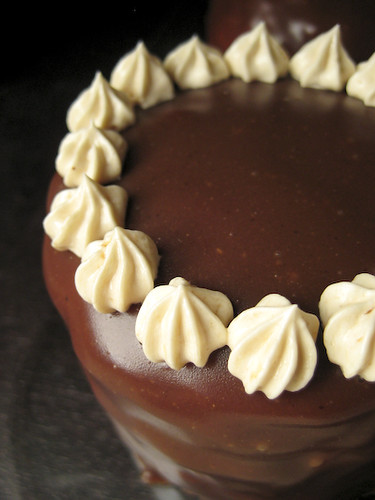
The other big challenge for me in this recipe was in creating a layer cake. I tend to have problems getting my layers cut evenly, or filling the layers nicely. Despite all the tricks in the book (twirling the cake on a stand while holding the knife in one place, marking with toothpicks and cutting, slicing with dental floss, etc.) I always seem to end up with uneven layers. Luckily for me, the mini cake option made cutting the cake much easier. I was able to simply lay the mini cake on its side and slice it like bread with a serrated knife. Some of my layers were less than perfect, but for the most part, I had much more success cutting these layers than I do when cutting a larger cake. I make just stick with cute mini cakes from now on!
As a side note - if you're interested in honing your layer cake skills, check out this new blogging event - Layers of Cake - hosted by Laurie of Quirky Cupcake.

Assembly was straight forward. I brushed each cake layer generously with the sugar syrup, but somehow ended up only using about three quarters of it. One huge difference between this gateau and the Opéra Cake was the cake itself. I found the Opéra Cake's jaconde to be a bit coarse in texture and slightly dry from the almond meal. The genoise in this recipe was so soft and moist in comparison - not coarse at all from the hazelnut meal (perhaps it was the trick of using the strainer in this recipe to avoid any large pieces of nuts?).
I skipped the step where we were supposed to cut the edge of the cake off to smooth it out - I'm guessing that's why my cake didn't turn out perfectly smooth around the edges like it was supposed to. I had some trouble with my ganache being too thin - it just ran over the edges of the cake and into the pan. I had to add an extra two ounces of melted chocolate, and then it was perfect.

My baking skills have vastly improved since I started this food blog. One thing that remains extremely lacking, however, are my cake decorating skills. This was my first time piping buttercream, and it's pretty obvious! I used my pastry bag and piped a few different designs on these mini cakes, but they still looked very amateur. I hope to be able to take cake decorating courses some day.

Be sure you heed the recommendation to leave the cake to sit at room temperature before serving. I did not initially see this and had my first few bites of this cake after it was well chilled. It was good, but the buttercream was too firm and the flavors were very mild. After it has been allowed to come to room temperature, the hazelnut, rum, and apricot flavors really shine. This cake was so good!
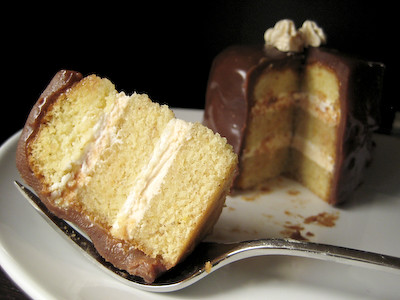
Thank you, Chris, for choosing this fantastic recipe. You challenged me to make a cake that I would have never made on my own. I discovered my love for praline paste, decorated with piped buttercream for the first time, and found out how enjoyable it is to make mini cakes! Make sure you visit the Daring Bakers Blogroll and see all the other beautiful cakes.
Filbert Gateau with Praline Buttercream
from Great Cakes by Carol Walter
1 Filbert Genoise, recipe below
1 recipe sugar syrup, flavored with dark rum, recipe below
1 recipe Praline Buttercream, recipe below
½ cup heavy cream, whipped to soft peaks
1 recipe Apricot Glaze, recipe below
1 recipe Ganache Glaze, prepared just before using, recipe below
3 tablespoons filberts, toasted and coarsely chopped
Filbert Genoise
Because of the amount of nuts in the recipe, this preparation is different from a classic genoise.
1 ½ cups hazelnuts, toasted/skinned*
2/3 cup cake flour, unsifted
2 Tbsp. cornstarch
7 large egg yolks
1 cup sugar, divided ¼ & ¾ cups
1 tsp. vanilla extract
½ tsp. grated lemon rind
5 large egg whites
¼ cup warm, clarified butter (100 – 110 degrees)
* To Skin Hazelnuts: Heat the oven to 300 degrees. Spread the hazelnuts on a baking sheet and toast them in the oven until golden brown, about 15 minutes. Immediately rub the hazelnuts between your fingers or the folds of a clean kitchen towel to remove their skins. You can use a paring knife to scrape the stubborn ones that won't come off otherwise. If there are too many to do this, bring water to a boil in a large saucepan, toss the hazelnuts in there for 30 seconds, then drain and rinse with cold water to stop the cooking process. The skins should easily come off now. Place them back in the oven for a few minutes to toast them.
** To Make Clarified Butter: Melt butter over low heat; use a spoon to remove the foam from the top. Let the butter sit for a few minutes to let all the milk solids sink to the bottom - you want the clear yellow liquid layer in the middle. (You need to use about 25% more butter than the desired amount of clarified butter you need. In this case, you should use 1/3 cup of butter to yield the desired 1/4 cup.)
Position rack in the lower 3rd of the oven and preheat to 350 degrees. Grease and flour a 10” X 2” inch round cake pan.
Using a food processor, process nuts, cake flour, and cornstarch for about 30 seconds. Then, pulse the mixture about 10 times to get a fine, powdery mixture. You’ll know the nuts are ready when they begin to gather together around the sides of the bowl. While you want to make sure there aren’t any large pieces, don’t over-process. Set aside.
Put the yolks in the bowl of an electric mixer (if you only have one mixer bowl, skip to the next paragraph and whisk the egg whites first to avoid any residual yolks in your bowl that might interfere with the whipping of the whites - then transfer the whites to a bowl and proceed with the yolks; no need to wash the bowl in between), with the whisk attachment, and beat until thick and light in color, about 3-4 minutes on med-high speed. Slowly, add ¾ cup of sugar. It is best to do so by adding a tablespoon at a time, taking about 3 minutes for this step. When finished, the mixture should be ribbony. Blend in the vanilla and grated lemon rind. Remove and set aside.
Place egg whites in a large, clean bowl of the electric mixer with the whisk attachment and beat on medium speed, until soft peaks. Increase to med-high speed and slowly add the remaining ¼ cup of sugar, over 15-20 seconds or so. Continue to beat for another ½ minute.
Add the yolk mixture to the whites and whisk for 1 minute.
Pour the warm butter in a liquid measure cup (or a spouted container). * It must be a deep bottom bowl and work must be fast.* Put the nut meal in a mesh strainer (or use your hand – working quickly) and sprinkle it in about 2 tablespoons at a time – folding it carefully for about 40 folds. Be sure to exclude any large chunks/pieces of nuts. Again, work quickly and carefully as to not deflate the mixture. When all but about 2 Tbsp. of nut meal remain, quickly and steadily pour the warm butter over the batter. Then, with the remaining nut meal, fold the batter to incorporate, about 13 or so folds.
With a rubber spatula, transfer the batter into the prepared pan, smoothing the surface with the spatula or back of a spoon. **If collected butter remains at the bottom of the bowl, do not add it to the batter! It will impede the cake rising while baking.
Tap the pan on the counter to remove air bubbles and bake in the preheated oven for 30-35 minutes (I baked my mini cakes for 25-30 minutes). You’ll know the cake is done when it is springy to the touch and it separates itself from the side of the pan. Remove from oven and allow to stand for 5 minutes. Invert onto a cake rack sprayed with nonstick coating, removing the pan. Cool the cake completely.
*If not using the cake right away, wrap thoroughly in plastic wrap, then in a plastic bag, then in the refrigerator for up to 3 days. If freezing, wrap in foil, then the bag and use within 2-3 months.
Sugar Syrup
Makes 1 cup, good for one 10-inch cake – split into 3 layers (I only used about 3/4 cup during the assembly)
1 cup water
¼ cup sugar
2 Tbsp. dark rum or orange flavored liqueur
In a small, yet heavy saucepan, bring the water and sugar to a boil and simmer for 5 minutes. Remove from heat, add the liqueur. Cool slightly before using on the cake. *Can be made in advance.
Praline Buttercream
1 recipe Swiss Buttercream (see below)
1/3 cup praline paste (see below)
1 ½ - 2 Tbsp. Jamaican rum (optional)
Blend ½ cup buttercream into the paste, then add to the remaining buttercream. Whip briefly on med-low speed to combine. Blend in rum.
Swiss Buttercream - (I used Dorie's buttercream instead)
4 lg. egg whites
¾ cup sugar
1 ½ cups (3 sticks) unsalted butter, slightly firm
1 ½ -2 Tbsp. Grand Marnier or liqueur of your choice
1 tsp. vanilla
Place the egg whites in a lg/ bowl of a electric mixer and beat with the whisk attachment until the whites are foamy and they begin to thicken (just before the soft peak stage). Set the bowl over a saucepan filled with about 2 inches of simmering water, making sure the bowl is not touching the water. Then, whisk in the sugar by adding 1-2 tablespoon of sugar at a time over a minutes time. Continue beating 2-3 minutes or until the whites are warm (about 120 degrees) and the sugar is dissolved. The mixture should look thick and like whipped marshmallows.
Remove from pan and with either the paddle or whisk attachment, beat the egg whites and sugar on med-high until its a thick, cool meringue – about 5-7 minutes. *Do not over beat*. Set aside.
Place the butter in a separate clean mixing bowl and, using the paddle attachment, cream the butter at medium speed for 40-60 seconds, or until smooth and creamy. *Do not over beat or the butter will become toooooo soft.*
On med-low speed, blend the meringue into the butter, about 1-2 Tbsp. at a time, over 1 minute. Add the liqueur and vanilla and mix for 30-45 seconds longer, until thick and creamy.
Refrigerate 10-15 minutes before using.
Wait! My buttercream won’t come together! Reheat the buttercream briefly over simmering water for about 5 seconds, stirring with a wooden spoon. Be careful and do not over beat. The mixture will look broken with some liquid at the bottom of the bowl. Return the bowl to the mixer and whip on medium speed just until the cream comes back together.
Wait! My buttercream is too soft! Chill the buttercream in the refrigerator for about 10 minutes and rewhip. If that doesn’t work, cream an additional 2-4 Tbsp. of butter in a small bowl– making sure the butter is not as soft as the original amount, so make sure is cool and smooth. On low speed, quickly add the creamed butter to the buttercream, 1 Tbsp. at a time.
Refrigerate in an airtight container for up to 5 days, or can be frozen for up to 6 months. If freezing, store in 2 16-oz. plastic containers and thaw in the refrigerator overnight or at room temperature for several hours.
Praline Paste (you can halve this recipe for the Praline Buttercream)
1 cup (4 ½ oz.) Hazelnuts, toasted/skinless
2/3 cup Sugar
Line a jelly roll pan with parchment and lightly butter.
Put the sugar in a heavy 10-inch skillet. Heat on low flame for about 10-20 min until the sugar melts around the edges. (Mine seemed to move from one side of the pan to the other - my stove may not heat evenly.)
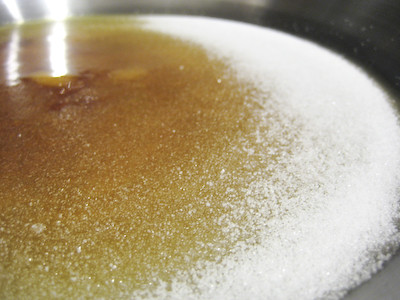
Do not stir the sugar. Swirl the pan if necessary to prevent the melted sugar from burning. Brush the sides of the pan with water to remove sugar crystals. (I had trouble removing the crystals from the edges.) If the sugar in the center does not melt, stir briefly. When the sugar is completely melted and caramel in color, remove from heat.
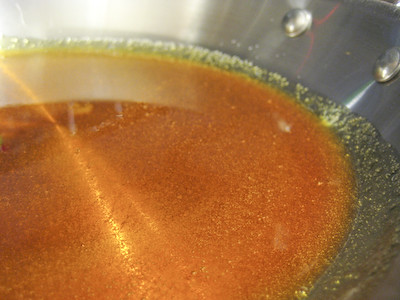
Stir in the nuts with a wooden spoon and separate the clusters. Return to low heat and stir to coat the nuts on all sides.

Cook until the mixture starts to bubble. **Remember – extremely hot mixture.** Then onto the parchment lined sheet and spread as evenly as possible. As it cools, it will harden into brittle.

Break the candied nuts into pieces and place them in the food processor.
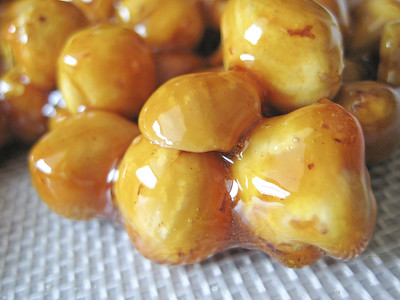
Pulse into a medium-fine crunch or process until the brittle turns into a powder. To make paste, process for several minutes. (If you have any stubborn chunks of praline brittle that won't turn into paste, just pour your paste into a small bowl and continue processing the chunks until the they become smooth.) Store in an airtight container and store in a cool dry place. Do not refrigerate.
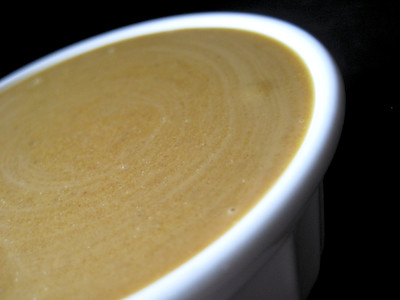
Apricot Glaze
Good for one 10-inch cake
2/3 cup thick apricot preserves
1 Tbsp. water
In a small, yet heavy saucepan, bring the water and preserves to a slow boil and simmer for 2-3 minutes. If the mixture begins to stick to the bottom of the saucepan, add water as needed.
Remove from heat and, using a strainer, press the mixture through the mesh and discard any remnants. With a pastry brush, apply the glaze onto the cake while the cake is still warm. If the glaze is too thick, thin to a preferred consistency with drops of water.
Ganache Glaze
Makes about 1 cup, enough to cover the top and sides of a 9 or 10 inch layer or tube cake
**Ganache can take on many forms. While warm – great fudge sauce. While cool or lukewarm – semisweet glaze. Slightly chilled – can be whipped into a filling/frosting. Cold & solid – the base of candied chocolate truffles.
6 oz. (good) semisweet or bittersweet chocolate, like Lindt (I used 8 oz. Callebaut Gianduja chocolate)
6 oz. (¾ cup heavy cream)
1 tbsp. light corn syrup
1 Tbsp. Grand Marnier, Cointreau, or dark Jamaican rum (optional) (I used Jamaican rum)
¾ tsp. vanilla
½ - 1 tsp. hot water, if needed
Blend vanilla and liqueur/rum together and set aside.
Break the chocolate into 1-inch pieces and place in the basket of a food processor and pulse until finely chopped. Transfer into a medium sized bowl and set aside.
Heat the cream and corn syrup in a saucepan, on low, until it reached a gentle boil. Once to the gently boil, immediately and carefully pour over the chocolate. Leave it alone for one minute, then slowly stir and mix the chocolate and cream together until the chocolate is melted and incorporated into the cream. Carefully blend in vanilla mixture. If the surface seems oily, add ½ - 1 tsp hot water. The glaze will thicken, but should still be pourable. If it doesn’t thicken, refrigerate for about 5 minutes, but make sure it doesn’t get too cold!
Assembling the Cake
Cut a cardboard disk slightly smaller than the cake. Divide the cake into 3 layers and place the first layer top-side down on the disk. Using a pastry brush, moisten the layer with 3-4 Tbsp. of warm sugar syrup. Measure out 1 cup of praline buttercream and set aside.
Spread the bottom layer with a ¼-inch thickness of the remaining buttercream. Cover with ½ of the whipped cream, leaving ¼-inch border around the edge of the cake. Place the middle layer over the first, brush with sugar syrup, spreading with buttercream. Cover with the remaining whipped cream.
Moisten the cut side of the third layer with additional sugar syrup and place cut side down on the cake. Gently, press the sides of the cake to align the layers. Refrigerate to chill for at least 30 minutes.
Lift the cake by sliding your palm under the cardboard. Holding a serrated or very sharp night with an 8-inch blade held parallel to the sides of the cake, trim the sides so that they are perfectly straight. Cut a slight bevel at the top to help the glaze drip over the edge. (I skipped this step - perhaps that is why my cake did not have smooth edges?) Brush the top and sides of the cake with warm apricot glaze, sealing the cut areas completely. Chill while you prepare the ganache.
Place a rack over a large shallow pan to catch the ganache drippings. Remove the gateau from the refrigerator and put it the rack. With a metal spatula in hand, and holding the saucepan about 10 inches above the cake, pour the ganache onto the cake’s center. Move the spatula over the top of the ganache about 4 times to get a smooth and mirror-like appearance. The ganache should cover the top and run down the sides of the cake. When the ganache has been poured and is coating the cake, lift one side of the rack and bang it once on the counter to help spread the ganache evenly and break any air bubbles. (Work fast before setting starts.) Patch any bare spots on the sides with a smaller spatula, but do not touch the top after the “bang”. Let the cake stand at least 15 minutes to set after glazing.
To garnish the cake, fit a 12 – 14-inch pastry bag with a #114 large leaf tip. Fill the bag with the reserved praline cream. Stating ½ inch from the outer edge of the cake, position the pastry tube at a 90 degree angle with the top almost touching the top of the cake. Apply pressure to the pastry bag, moving it slightly toward the center of the cake. As the buttercream flows on the cake, reverse the movement backward toward the edge of the cake and finish by pulling the bag again to the center. Stop applying pressure and press the bag downward, then quickly pull the tip up to break the flow of frosting. Repeat, making 12 leaves evenly spaced around the surface of the cake.
Make a second row of leaves on the top of the first row, moving the pastry bag about ¾ inch closer to the center. The leaves should overlap. Make a 3rd row, moving closer and closer to the center. Add a 4th row if you have the room. But, leave a 2-inch space in the center for a chopped filbert garnish. Refrigerate uncovered for 3-4 hours to allow the cake to set. Remove the cake from the refrigerator at least 3 hours before serving.
Leftover cake can be covered with foil and kept in the refrigerator for up to 5 days.










I love that you made little cakes! They are adorable
ReplyDeleteI love your mini cakes....so cute. And your decoration is just perfect for an elegant little cake.
ReplyDeleteI cut out the middle man and used hazelnut flour(ground hazelnuts) so no having to deal with the skin for me.
ReplyDeleteThe mini ones are very cute.
So cute! Gotta love minis.
ReplyDeleteI didn't realize how lucky I was to have a grocery store that stocks peeled hazelnuts!
love the cute mini cakes! I think they look great. Thanks for the link to the pan as well. Your pics are wonderful especially the brittle. great job. your galette looks delicious too!
ReplyDeleteHa! I was cursing my decision to skin my own almonds for the praline... and I ALMOST took a picture of the pile of skins, too. ;)
ReplyDeleteYour individual cakes look perfect to me - you have VERY lucky co-workers!
Your decorating and cake-making skills are uncanny!!
ReplyDeleteJaime, I absolutely LOVE your mini cakes! I'm so jealous...I think I need new pans. ;) Your cake (and your pics) look AMAZING!
ReplyDeleteI think your idea of making them into individual cakes is great... that way mentally folks don't feel like they are sharing - lol :) They look absolutely perfect!
ReplyDeleteReally like the look of your small packages! Great work!
ReplyDeleteI made mini's too but yours are much cuter! Great job!
ReplyDeleteYour cakes look great! You did a wonderful job. (We're hardest on ourselves.) I would have taken one look at the ingredient list and instructions and moved on to something easy like chocolate chip cookies, the drop and bake kind!
ReplyDeleteIn reading your post you wrote that you wanted to take a cake decorating class. I just finished taking my second course this past Monday. May I make a suggestion? Before you sign up and pay make sure the instructor knows what she is doing and can pass that information on to you. For my third course I am forced to find a new instructor.
Sorry, I know this comment is kinda long....I have those exact cake pans but have yet to use them. Your batter didn't leak? I'm a scaredy cat and worry about changing anything from a recipe.
You really did a terrific job and your decorating skills are better than most!
I had to sit this challenge out but your little cakes and description make me still want to try it. Maybe you could just send me a little cake instead? :)
ReplyDeleteYour little cakes make me crave hazelnuts! The look impeccable.
ReplyDeleteThey are adorable Jaime. Too freakin cute. Thanks for the linkage too. MUAH!
ReplyDeleteI love the look of the mini cakes. They look so pretty!
ReplyDeleteMmmm, that looks really really good. I like the height you have too.
ReplyDeleteYour little cakes are gorgeus! I also pealed hazelnuts myself, so I know what you mean ;)
ReplyDeletemini is always better. and can i just say, i really wish i was one of your coworkers. seriously, i'll go back to school for whatever degree i need and change jobs just to partake of your treats. :)
ReplyDeleteI know you said your cakes are uneven, the ganache didn't pour right, and your cake decorating skills are hopeless, but still. Your cakes are gorgeous!
ReplyDeleteLovely cake, wish I could put my hand through my computer screen to grab a bite.
ReplyDeleteYour cakes looks great! That pan looks like it would come in really handy. I will have to look for it.
ReplyDeletelovely!!
ReplyDeleteGetting the skins off the hazelnuts was a big problem for me too, among others. Your little cakes look great!
ReplyDeleteEven with constant work, I never was able to clean up those hazelnuts enough - you did a spectacular job.
ReplyDeleteThe minis are sweet.
I love the mini cakes ... IF (and that's a big one) I decide to try this again, it'll be mini cakes! Great Job!!
ReplyDeleteOh my, I could take a good bite out of your cake. I love how "fudgy" the ganache looks. Great job!
ReplyDeleteI love the mini cakes! Just beautiful!
ReplyDeleteWow, that looks like a LOT OF WORK. But yours came out absolutely beautifully. I really like the mini-cake idea; who makes your cakepan with the removable bottoms? I never bake cakes anymore because it's just two much for my partner and me, so the thought of mini-cakes is really quite intriguing...
ReplyDeleteneen - thanks! i am in love w/mini cakes now after this challenge :) there is already a link in my blog post about where you can purchase the same cake pan i used...
ReplyDeleteHow cute! Your ganache and buttercream look perfect! Lovely pics!
ReplyDeleteLooks great! Impressed that you did the hazelnuts from scratch. I didn't pay attention to how long to process the pralines, so my "paste" was ore like crumble!
ReplyDeleteYour mini cakes look great! I agree, skinning the hazelnuts was by far the most annoying part of this challenge. Your photos look great--I love the one of the hazelnut skins. =)
ReplyDeleteWhat cute little mini-cakes! I love your hazelnut pictures!
ReplyDeleteOoo! Love the mini cakes they are so perfect! Your decoration is beautiful!
ReplyDeleteYour cake is absolutely gorgeous! The little cakes are so pretty.
ReplyDeleteGreat job on your mini cake. Your ganache is so smoothe.
ReplyDeleteThanks for the helpful tips! They would come really useful if I ever gather up the courage to make something like this.
ReplyDelete